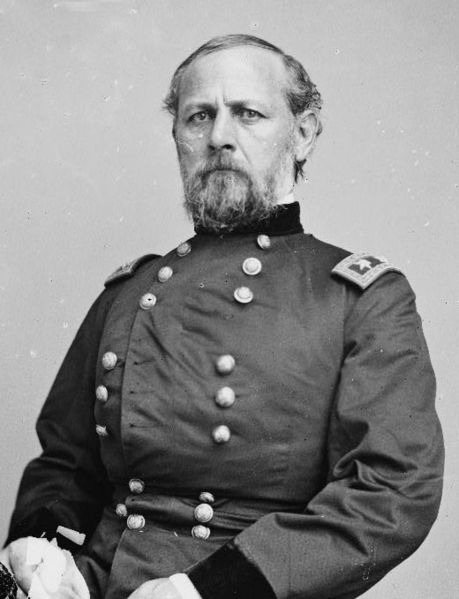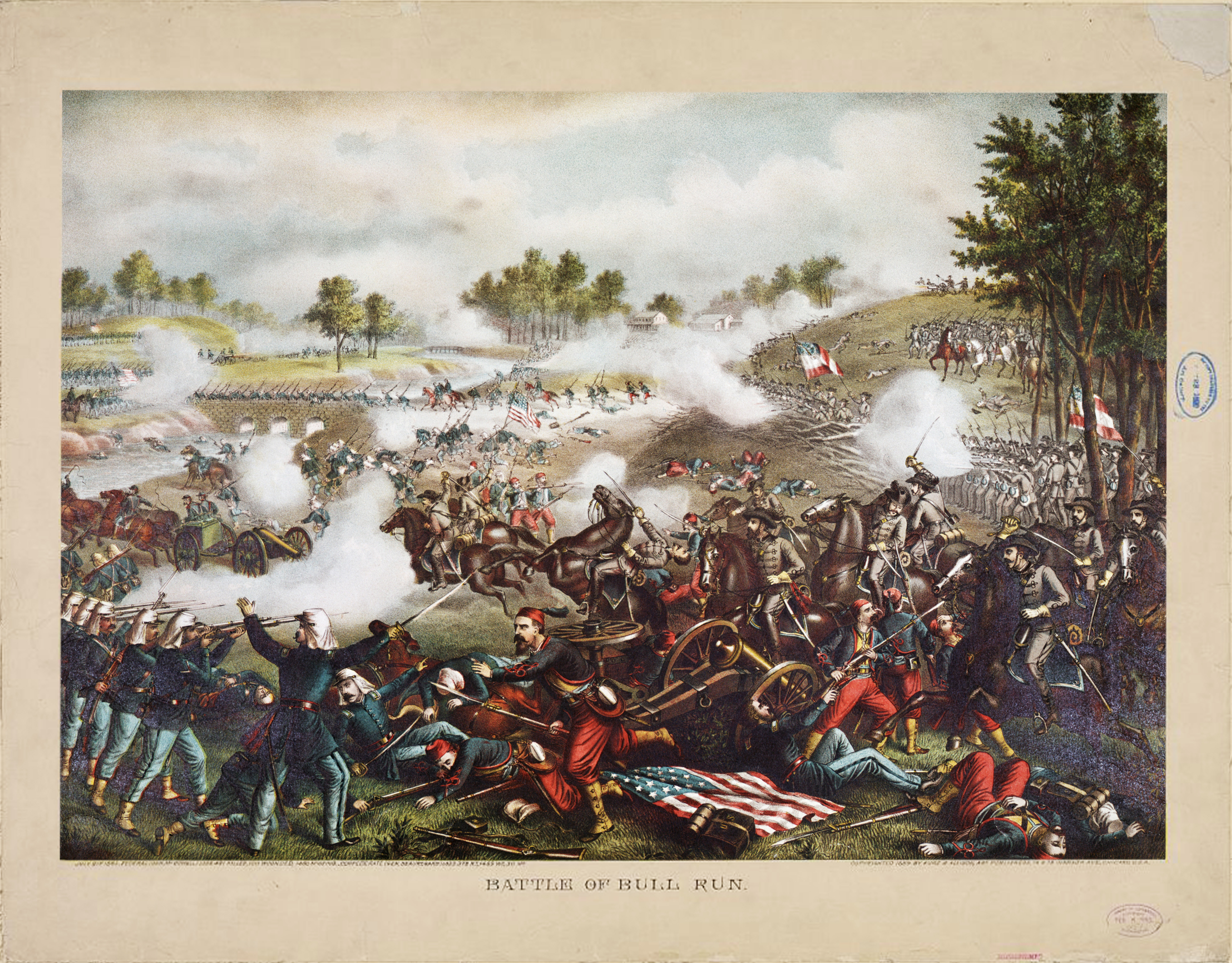Fort Sumter
 |
| George McClellan who replaced McDowell as commander of troops and later Scott as general in chief. |
The War did not officially begin until the battle of Bull Run, which wasn't far from Washington D.C., in July of 1861. An estimated 20,000 Confederate troops were gathered at Manassas Junction, Virginia when General Windfield Scott decided to send a poorly trained batch of Union soldiers under General Irvin McDowell to advance against the Confederate forces. The two armies clashed on July 21, 1861 and thus, the Civil War formally began. During the majority of the battle the Union had the upper hand until Confederate forces were sent in from Shenandoah Valley. With the help of more soldiers the Confederates were able to break the Union right flank, sending the Union soldiers into a chaotic retreat towards Washington. Thus, with the scrambled retreat, the confederacy had won this battle. The Battle of Bull Run convinced the Lincoln administration and the North that the Civil War wouldn't be as easy to win as they thought it would.
Shiloh
 |
| General Buell |
Merrimack vs. Monitor
 After the Battle of Shiloh naval tensions and operations increased significantly because of the Union capture of New Orleans and the unions presence in the mouth of the Mississippi River. Soon strategically located bases helped create a Union blockade off of the southern coast. However there was an alarming Confederate threat to the blockade, the Merrimack (renamed the Virginia) threatened catastrophe to entire Yankee blockading fleet. The Union's strongest ironclad, the Monitor, was sent to battle the Merrimack. The world’s first battle between steam-powered, ironclad warships ended in a draw, but its impact on the future of naval warfare would be extreme.
After the Battle of Shiloh naval tensions and operations increased significantly because of the Union capture of New Orleans and the unions presence in the mouth of the Mississippi River. Soon strategically located bases helped create a Union blockade off of the southern coast. However there was an alarming Confederate threat to the blockade, the Merrimack (renamed the Virginia) threatened catastrophe to entire Yankee blockading fleet. The Union's strongest ironclad, the Monitor, was sent to battle the Merrimack. The world’s first battle between steam-powered, ironclad warships ended in a draw, but its impact on the future of naval warfare would be extreme.
In September of 1862 Confederate General Robert E. Lee lead his fresh-from-battle troops to Maryland to attempt at isolating Washington D.C. from the north. The Army of the Potomac, under the command of George McClellan, soon reached Lee and his troops and attacked at Sharpsburg, and the bloodiest battle soon took place. After the dust had settled the death count was over 6000 and wounded over 17000. While the Battle of Antietam is considered a draw from a military point of view, Abraham Lincoln and the Union claimed victory. This tough battle, which drove Lee’s forces away Maryland, gave Lincoln the “victory” that he needed before delivering the Emancipation Proclamation — a document that would forever change the geopolitical course of the American Civil War.
Chancellorsville
Vicksburg
 For almost a year, Ulysses S. Grant and his army had been trying to take away the Confederate river fortress of Vicksburg, Mississippi. The only obstacle standing in their way was the unstoppable defenses at Vicksburg. Finally, one day Grant and his men crossed the river separating them from Vicksburg. After unsuccessful attempts at damaging the defenses, on May 22 Grant decided to siege the fort and the surrounding city. In May and June of 1863, Grant’s armies converged on Vicksburg, investing the city and entrapping a Confederate army under General Pemberton. On July 4, Vicksburg surrendered after the prolonged siege. The tactic Grant used is considered one of the most brilliant military campaigns of the war. With the loss of Pemberton’s army and this vital stronghold on the Mississippi, the Confederacy split in half. Grant's successes in the West boosted his reputation, leading ultimately to his appointment as General-in-Chief of the Union armies.
For almost a year, Ulysses S. Grant and his army had been trying to take away the Confederate river fortress of Vicksburg, Mississippi. The only obstacle standing in their way was the unstoppable defenses at Vicksburg. Finally, one day Grant and his men crossed the river separating them from Vicksburg. After unsuccessful attempts at damaging the defenses, on May 22 Grant decided to siege the fort and the surrounding city. In May and June of 1863, Grant’s armies converged on Vicksburg, investing the city and entrapping a Confederate army under General Pemberton. On July 4, Vicksburg surrendered after the prolonged siege. The tactic Grant used is considered one of the most brilliant military campaigns of the war. With the loss of Pemberton’s army and this vital stronghold on the Mississippi, the Confederacy split in half. Grant's successes in the West boosted his reputation, leading ultimately to his appointment as General-in-Chief of the Union armies.
The Battle of Gettysburg, fought in July of 1863, is considered the most important event of the American Civil War. After the victory in Chancellorsville, Lee and his men reached Gettysburg, Pennsylvania in late jun of 1863 to put Lee's plan of an all-out invasion of the Northeast into action.On July 1, the advancing Confederates clashed with the Union's Army of the Potomac, commanded by General Meade, at the crossroads town of Gettysburg. On July 3, Lee ordered an attack by fewer than 15,000 troops on the enemy's center at Cemetery Ridge. This assault eventually failed forcing Lee and his men toward Virginia a day later. Lee's plan to invade the North fell apart after the Union's victory at Gettysburg. Four months after the battle, President Lincoln used the dedication ceremony for Gettysburg's Soldiers National Cemetery to honor the fallen Union soldiers and redefine the purpose of the war in his historic Gettysburg Address.
Sherman’s March
Appomattox Courthouse
Civil War Medicine
During the 1860s, doctors had yet to develop bacteriology and were generally ignorant of the causes of disease. Generally, Civil War doctors went to only two years of medical school, though some pursued more education. Most Civil War surgeons had never treated a gun shot wound and many had never performed surgery. For the most part, the Civil War doctor (as understaffed, under qualified, and under-supplied as he was) did the best he could, with what he was given. Some 10,000 surgeons served in the Union army and about 4,000 served in the Confederate. Medicine made significant gains during the course of the war. Although, medical knowledge of the 1860s had not yet discovered the use of sterile dressings, antiseptic surgery, and the recognition of the importance of sanitation and hygiene. As a result, thousands died from diseases such as typhoid or dysentery. One of the main struggles of a surgeon is when a soldier is shot in the leg or arm and that limb must be amputated. So here is a video kind of explaining what was going on in the operating room when this was happening:
Battle Technology/Tactics
Life as a Soldier
 |
| A letter from a soldier to his family on thanksgiving day almost 200 years ago |





No comments:
Post a Comment